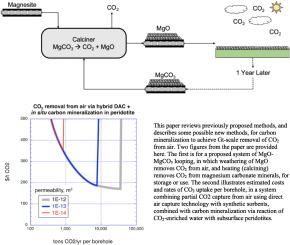当前位置:
X-MOL 学术
›
Chem. Geol.
›
论文详情
Our official English website, www.x-mol.net, welcomes your feedback! (Note: you will need to create a separate account there.)
Engineered carbon mineralization in ultramafic rocks for CO2 removal from air: Review and new insights
Chemical Geology ( IF 3.9 ) Pub Date : 2020-09-01 , DOI: 10.1016/j.chemgeo.2020.119628 Peter B. Kelemen , Noah McQueen , Jennifer Wilcox , Phil Renforth , Greg Dipple , Amelia Paukert Vankeuren
Chemical Geology ( IF 3.9 ) Pub Date : 2020-09-01 , DOI: 10.1016/j.chemgeo.2020.119628 Peter B. Kelemen , Noah McQueen , Jennifer Wilcox , Phil Renforth , Greg Dipple , Amelia Paukert Vankeuren

|
Abstract Carbon Dioxide removal from air (CDR) combined with permanent solid storage can be accomplished via carbon mineralization in ultramafic rocks in at least four ways: 1. Surficial CDR: CO2-bearing air and surface waters are reacted with crushed and or ground mine tailings, alkaline industrial wastes, or sedimentary formations rich in reactive rock fragments, all with a high proportion of reactive surface area. This can be implemented at a low cost, but most proposed methods have a very large area footprint at the gigatonne scale. The area requirement can be greatly reduced by calcining (heating to produce pure CO2 for permanent storage or use) followed by recycling of MgO, CaO, Na2O, … Such looping methods have predicted costs that are as low or lower than for direct air capture with synthetic sorbents or solvents (DACSS), and a similar area footprint. 2. In situ CDR: CO2-bearing surface waters are circulated through rock formations at depth. These methods potentially have a cost similar to that of surficial carbon mineralization, and a giant storage capacity with reduced surface area requirements, but they involve uncertain feedbacks between permeability, reactive surface area, and reaction rate, providing a fascinating topic for fundamental research. Furthermore, the size, injectivity, permeability, geomechanics, and microstructure of key subsurface reservoirs for in situ CDR remain almost entirely unexplored. 3&4. Combined partial enrichment of CO2 using direct air capture with synthetic sorbents (DACSS) plus surficial carbon mineralization (3) or in situ carbon mineralization (4). Energy requirements and total costs for partial enrichment of CO2 are substantially lower than for enrichment to high purity. CO2 enriched air can be sparged through mine tailings at the surface, and/or through water to increase dissolved carbon concentrations prior to circulation through rock reactants. Such combined or hybrid approaches have not been investigated thoroughly, and offer many avenues for optimization.
中文翻译:

用于从空气中去除二氧化碳的超基性岩石中工程碳矿化:回顾和新见解
摘要 从空气中去除二氧化碳 (CDR) 结合永久固体储存可以通过超基性岩中的碳矿化至少以四种方式实现: 1. 表面 CDR:含二氧化碳的空气和地表水与压碎或磨碎的尾矿反应、碱性工业废物或富含反应性岩石碎片的沉积地层,所有这些都具有高比例的反应性表面积。这可以以低成本实现,但大多数提议的方法在千兆吨级具有非常大的面积足迹。通过煅烧(加热以产生用于永久储存或使用的纯 CO2),然后回收 MgO、CaO、Na2O 等,可以大大减少面积需求……这种循环方法预测的成本与直接空气捕获的成本一样低或更低合成吸附剂或溶剂 (DACSS),和类似的面积足迹。2. 原位 CDR:含 CO2 的地表水通过深部岩层循环。这些方法可能具有与表面碳矿化相似的成本,以及巨大的存储容量和减少的表面积要求,但它们涉及渗透率、反应表面积和反应速率之间的不确定反馈,为基础研究提供了一个引人入胜的课题。此外,原位 CDR 的关键地下储层的大小、注入能力、渗透率、地质力学和微观结构几乎完全未开发。3&4。使用直接空气捕获与合成吸附剂 (DACSS) 以及表面碳矿化 (3) 或原位碳矿化 (4) 结合部分富集 CO2。部分富集 CO2 的能源需求和总成本大大低于富集至高纯度的成本。富含二氧化碳的空气可以通过地表的尾矿和/或通过水喷射,以在通过岩石反应物循环之前增加溶解碳的浓度。这种组合或混合方法尚未得到彻底研究,并提供了许多优化途径。
更新日期:2020-09-01
中文翻译:

用于从空气中去除二氧化碳的超基性岩石中工程碳矿化:回顾和新见解
摘要 从空气中去除二氧化碳 (CDR) 结合永久固体储存可以通过超基性岩中的碳矿化至少以四种方式实现: 1. 表面 CDR:含二氧化碳的空气和地表水与压碎或磨碎的尾矿反应、碱性工业废物或富含反应性岩石碎片的沉积地层,所有这些都具有高比例的反应性表面积。这可以以低成本实现,但大多数提议的方法在千兆吨级具有非常大的面积足迹。通过煅烧(加热以产生用于永久储存或使用的纯 CO2),然后回收 MgO、CaO、Na2O 等,可以大大减少面积需求……这种循环方法预测的成本与直接空气捕获的成本一样低或更低合成吸附剂或溶剂 (DACSS),和类似的面积足迹。2. 原位 CDR:含 CO2 的地表水通过深部岩层循环。这些方法可能具有与表面碳矿化相似的成本,以及巨大的存储容量和减少的表面积要求,但它们涉及渗透率、反应表面积和反应速率之间的不确定反馈,为基础研究提供了一个引人入胜的课题。此外,原位 CDR 的关键地下储层的大小、注入能力、渗透率、地质力学和微观结构几乎完全未开发。3&4。使用直接空气捕获与合成吸附剂 (DACSS) 以及表面碳矿化 (3) 或原位碳矿化 (4) 结合部分富集 CO2。部分富集 CO2 的能源需求和总成本大大低于富集至高纯度的成本。富含二氧化碳的空气可以通过地表的尾矿和/或通过水喷射,以在通过岩石反应物循环之前增加溶解碳的浓度。这种组合或混合方法尚未得到彻底研究,并提供了许多优化途径。


























 京公网安备 11010802027423号
京公网安备 11010802027423号